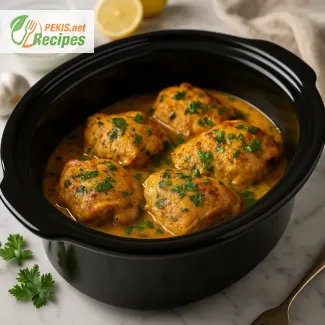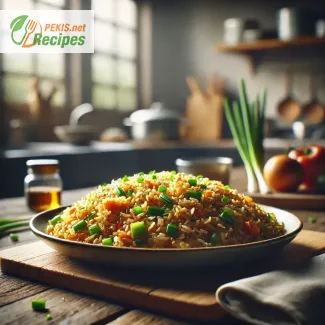
Irresistibly Juicy Oven-Roasted Chicken Legs for Any Occasion
Discover the perfect balance of crispiness, tenderness, and flavor in every bite
There’s something undeniably satisfying about baked chicken legs that are perfectly crisp on the outside and irresistibly juicy on the inside. Whether you’re preparing a comforting family dinner or hosting a casual weekend gathering, this easy baked chicken leg recipe brings both simplicity and flavor to the table. Known for its succulent dark meat and rich taste, chicken leg meat absorbs marinades beautifully and delivers exceptional results even with minimal ingredients. It’s no wonder this cut has become a household favorite across countless kitchens.
Unlike more delicate cuts, chicken legs remain moist and flavorful even after extended cooking, making them a forgiving and reliable choice for cooks of all skill levels. Their robust flavor pairs well with a wide array of herbs, spices, and marinades, from smoky paprika and earthy thyme to vibrant lemon zest and garlic. When roasted in the oven, the skin crisps up beautifully while locking in the meat’s natural juices, creating a contrast in texture that’s simply addictive.
Why chicken leg meat is the star of your next dinner
The appeal of chicken leg meat lies in its rich texture, deeper flavor, and versatility. While chicken breasts are often considered a lean choice, they can easily dry out during cooking. In contrast, the higher fat content in chicken thighs and drumsticks allows them to stay moist and flavorful, even when baked at high temperatures. This makes them ideal for roasting, grilling, slow cooking, or air frying—though the oven remains the classic method for achieving that perfect golden-brown skin.
When properly seasoned and baked, oven-roasted chicken legs can rival even the most complex dishes in taste. The recipe is flexible enough to suit a variety of diets and can be adjusted to be spicy, sweet, herby, or tangy, depending on your preferences. With just a handful of pantry staples, you can create a dish that’s both comforting and impressive—perfect for a quick weeknight meal or a festive weekend spread.
Perfectly crispy outside, tender and juicy inside
The secret to achieving crispy chicken skin without deep-frying lies in the oven’s dry heat. By roasting the legs at a higher temperature, you allow the skin to render its fat and become crisp while the inside stays moist and flavorful. A short marinade or dry rub beforehand can enhance the taste even further. Ingredients like garlic powder, smoked paprika, onion flakes, and olive oil contribute depth, while a touch of lemon or vinegar helps tenderize the meat and add brightness.
As the chicken bakes, its juices mingle with the seasoning, creating a natural sauce that can be spooned over the meat or soaked up with sides like roasted vegetables, mashed potatoes, or steamed rice. For best results, arrange the legs on a wire rack over a baking tray to allow air to circulate evenly around each piece. This method ensures uniform browning and minimizes sogginess.
A dish loved across generations and cultures
Chicken legs are not only delicious—they’re also economical and easy to find. From traditional Southern-style baked chicken to Mediterranean herbed drumsticks, the global love for this humble cut of meat transcends culinary borders. Its adaptability has made it a staple in homes worldwide, whether baked with rosemary in Italy, glazed with honey and soy sauce in Asia, or seasoned with cumin and coriander in North Africa.
This recipe embraces that universal appeal while focusing on simplicity and flavor. It’s designed to highlight the natural richness of the meat while offering options for customization. Whether you’re serving it hot out of the oven or enjoying the leftovers cold the next day, this dish will quickly become one of your go-to favorites.
How to make your chicken legs truly unforgettable
The key to unforgettable baked chicken legs starts with good-quality meat. Look for legs with smooth, unblemished skin and a healthy pink color. If time allows, let them marinate for at least an hour before baking to allow the flavors to penetrate the meat. Patting the skin dry with a paper towel before placing them in the oven will help enhance crispiness.
Don’t forget the importance of timing and temperature. Baking at 200°C (400°F) for 35–45 minutes usually yields the best texture, with the skin crisp and the meat cooked through. Using a meat thermometer can help ensure your chicken reaches a safe internal temperature of 74°C (165°F) without becoming dry. And once it’s out of the oven, let the legs rest for a few minutes to allow the juices to redistribute—this step is often overlooked but makes a noticeable difference.
With its rich flavor, ease of preparation, and wide appeal, this easy baked chicken leg recipe is bound to become a staple in your kitchen. From the first sizzle in the oven to the final crispy bite, every step of the cooking process offers a sensory reward worth savoring.
- Preheat the oven to 200°C (400°F). Line a baking sheet with parchment paper or use a baking rack placed over a tray for even crispiness.
- Pat the chicken legs dry with a paper towel to ensure the skin crisps up during baking.
- In a large bowl, mix olive oil, lemon juice, garlic powder, onion powder, smoked paprika, dried thyme, black pepper, and salt to create a marinade.
- Rub the chicken legs thoroughly with the marinade, ensuring each piece is evenly coated. Let it rest for 10 minutes at room temperature (or marinate for up to 4 hours in the refrigerator for deeper flavor).
- Arrange the legs on the baking tray or rack, skin side up, ensuring there’s space between each piece.
- Bake in the preheated oven for 35–40 minutes or until the internal temperature reaches 74°C (165°F) and the skin is golden and crisp.
- Let the chicken rest for 5 minutes after baking before serving to allow juices to settle.
Elevating the Classic: Creative Enhancements for Baked Chicken Legs
Transforming a simple recipe into a gourmet experience
The humble baked chicken leg is a staple in kitchens around the world, prized for its simplicity, rich flavor, and ease of preparation. But even the most beloved recipes can benefit from thoughtful adjustments and culinary creativity. Whether you're looking to enhance flavor, boost nutritional value, or avoid common pitfalls, there are many ways to take your chicken leg dish from everyday to extraordinary.
Adding depth with spices, herbs, and aromatics
One of the most effective ways to enhance the flavor of oven-roasted chicken legs is through the use of aromatic spices and herbs. While traditional recipes often call for garlic, paprika, and thyme, experimenting with more global flavors can yield delicious results.
For example:
- Cumin and coriander introduce an earthy, slightly citrusy depth, reminiscent of Middle Eastern cuisine.
- Fresh rosemary and sage bring a robust, woody aroma that pairs wonderfully with roasted poultry.
- Turmeric and ginger add both color and anti-inflammatory benefits, creating a mildly spicy profile with warming notes.
- Cayenne pepper or chili flakes can be added for those who enjoy a bit of heat, transforming a mild dish into something bolder.
A small amount of brown sugar or honey in the marinade can balance out spicy or acidic flavors and assist in caramelization, enhancing the golden crust on the skin. Similarly, a touch of soy sauce or Worcestershire sauce deepens the umami character of the meat without overpowering it.
Moisture and tenderness through marination
Marinating chicken legs not only infuses flavor but also contributes to juicier, more tender meat. Acidic components such as lemon juice, vinegar, or yogurt break down muscle fibers, leading to a more succulent bite. However, it’s important not to over-marinate, especially with strong acids, which can result in a mushy texture.
A balanced marinade includes:
- A fat like olive oil to coat the meat and help distribute flavor.
- An acid, such as citrus or vinegar, to tenderize.
- Aromatics like garlic, onion, and herbs for depth.
- A touch of sweetness to promote browning and balance acidity.
Letting the meat sit for 2 to 4 hours, or even overnight, allows the flavors to fully penetrate. Always marinate in the refrigerator and avoid metal containers that may react with acids.
Homemade versus store-bought: why scratch wins
Cooking chicken legs at home gives you complete control over ingredients, cooking time, and seasoning levels. Store-bought or pre-marinated chicken often includes preservatives, excess sodium, and added sugars that can dull the flavor and nutritional quality.
A homemade baked chicken leg recipe:
- Allows for customization to dietary needs or flavor preferences.
- Offers higher quality and freshness with minimal additives.
- Avoids unnecessary oils or sugars commonly found in pre-packaged options.
- Results in better texture, as it can be cooked to perfection rather than overdone for safety in mass production.
By preparing your meal from scratch, you're also free to choose ethically sourced meat and incorporate organic ingredients, leading to a more wholesome and satisfying experience.
Common mistakes to avoid
Even a simple dish like baked chicken legs can fall short due to easily avoidable errors. Here are the top mistakes home cooks often make:
- Skipping the drying step: If the skin is not patted dry, it will steam rather than roast, resulting in soggy skin.
- Overcrowding the pan: Chicken needs space for hot air to circulate. Crowding leads to uneven cooking and a lack of crispness.
- Undercooking or overcooking: Always use a meat thermometer. Chicken legs are done at 74°C (165°F) but still juicy and tender.
- Not letting the meat rest: Resting for just 5–10 minutes after baking helps the juices redistribute and keeps the meat moist.
- Uneven seasoning: Failing to coat each leg thoroughly can result in bland bites. Rubbing seasoning under the skin can also enhance flavor.
Healthier alternatives and ingredient swaps
For those looking to make the dish a bit healthier without sacrificing flavor, a few strategic substitutions can go a long way:
- Use skinless chicken legs to reduce fat content while still enjoying dark meat’s flavor.
- Swap olive oil for avocado oil for a higher smoke point and additional heart-healthy fats.
- Replace salt with low-sodium herb blends or use lemon zest to add brightness without increasing sodium.
- Add vegetable sides like roasted carrots or cauliflower instead of heavy starches.
- For a lower-fat option, bake on a wire rack so that fat drips away from the meat, resulting in a leaner finish.
For an added fiber boost, consider serving the chicken with whole grains like quinoa or farro instead of white rice or mashed potatoes.
Flavor boosters for advanced palates
If you’re comfortable in the kitchen and want to elevate the dish further, try these gourmet-level additions:
- Finish with compound butter (e.g., garlic herb or chili lime) for added richness.
- Deglaze the pan with a splash of white wine or chicken stock and make a light pan sauce.
- Stuff fresh herbs like rosemary or sage under the skin before baking for intensified aroma.
- Add a crunchy breadcrumb or nut crust in the final 10 minutes for a crispy, golden finish.
Small touches like garnishing with fresh parsley, adding a dollop of Greek yogurt dip, or serving with a citrus wedge can also elevate presentation and flavor, making the meal feel restaurant-worthy.
At the heart of it, baked chicken legs are a canvas for creativity. Whether you prefer them classic or bold, spicy or comforting, every tweak offers an opportunity to make the recipe yours. With a little attention to detail and a few inspired changes, this traditional dish can become a deeply personal and memorable culinary experience—one that not only tastes better but also tells a story of care, quality, and intention.
Contains allergens: None directly, but check spice blends and lemon juice for additives.
Gluten: Naturally gluten-free.
Substitution tips for allergens and gluten:
- If allergic to garlic or onion powder, substitute with ground fennel or celery seed powder for similar umami.
- Always verify that spices and lemon juice are gluten-free certified if required.
- Vitamin B6: 0.8 mg (57% DV) – supports brain health and metabolism
- Vitamin B12: 1.2 µg (50% DV) – essential for red blood cell formation
- Iron: 1.5 mg (18% DV) – important for oxygen transport
- Zinc: 2.7 mg (24% DV) – supports immune function and healing
- Phosphorus: 280 mg (40% DV) – strengthens bones and teeth
- Niacin (Vitamin B3): 9 mg (56% DV) – aids energy production
- Lycopene (from paprika): ~450 µg – may reduce oxidative stress
- Flavonoids (from thyme and lemon): ~8 mg – support heart and immune health
- Vitamin E (from olive oil): ~1.5 mg – protects cells from oxidative damage





